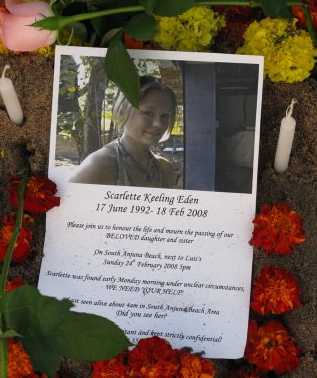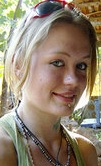 I’m
standing with my back to the Arabian Sea. The wind is up and
surf crashes on the beach behind me as its spray and hot salty
gusts of wind push me forward, almost off balance; but I’m
being supported by the strong and steady hands that I’m
holding, to my left and to my right.
I’m
standing with my back to the Arabian Sea. The wind is up and
surf crashes on the beach behind me as its spray and hot salty
gusts of wind push me forward, almost off balance; but I’m
being supported by the strong and steady hands that I’m
holding, to my left and to my right.
Eyes
closed; my visual field is deep dark red. I’m being suspended
in a timeless moment and I’ve become the roar of the surf,
the shove of the wind on my back, and the steady stream of tears
that flow down my cheeks and drip, drip, drip to the sand below.
I’m
trying to sense differences in the texture, the strength of
the grip, and the energy in the hands I’m holding, but
I can find none. Their energy and mine has merged into a continuous
field of energy that is flowing through the 150 pairs of linked
hands that form the outer circle of a mandala that has been
spontaneously created this afternoon on the windswept and blackened
sands of Anjuna Beach, Goa.
An
unbearable lump has formed in the back of my throat. It is choking
my breath. I suppress the urge to let go -- to relax both my
grip on the hands that I hold, and my emotions.
A few
more minutes pass. My breath now comes in halting gasps, my
throat is constricted. My heart labors, my guts ache. I’m
in pain, a deep systemic pain over the loss of a young life,
needlessly taken, criminally wasted before it ever had time
to flower and bloom into maturity.
Using
a skill learned from yoga, I consciously slow my breath until
it is deeper and more rhythmic. Soon the tightness in my chest
eases and my throat relaxes, the physical pain subsides. My
breath softens, and I’m able to open my eyes and gaze
once more at the beautiful, yet distressing sight in front of
me. Focusing on a cluster of white roses in the center of the
mandala, I allow their exquisite forms to refresh me and ease
my transition to acceptance and peace.
On
my left, I hold the hand of Oystein, a 6 feet tall, 35-year-old
Norwegian journalist. To my right, I hold the hand of a slightly
built, 60-year-old local Goan beach vendor called Hejera. I
scan the circumference of this almost perfectly formed circle
of silent souls, young and old, white and black, gathered here
by happenstance from all parts of the world and now united in
this spontaneous outpouring of grief.
 My
eyes follow the long flowing outer lines of the lotus petals
of the mandala. It was created by the hands of many: mothers,
children and passers-by, who scooped out shallow depressions,
and filled them lovingly with hundreds of orange, red and purple
marigold blossoms. A man in a loincloth has knelt to strike
a brass bell; he has taken the role of leader of this impromptu
memorial service. Its chime persists. An aroma of Frankincense
rises from small burners placed in the flowers and gently wafts
over the crowd.
My
eyes follow the long flowing outer lines of the lotus petals
of the mandala. It was created by the hands of many: mothers,
children and passers-by, who scooped out shallow depressions,
and filled them lovingly with hundreds of orange, red and purple
marigold blossoms. A man in a loincloth has knelt to strike
a brass bell; he has taken the role of leader of this impromptu
memorial service. Its chime persists. An aroma of Frankincense
rises from small burners placed in the flowers and gently wafts
over the crowd.
My
eyes continue to follow the sensuous lines that form the graceful
arcs of the mandala’s lotus petals. Eventually, they return
again to the center, the still point, and the cluster of four
dozen or more roses, red and white, whose stems have been planted
in the sand.
Among
them have been placed two black and white photos of Scarlett
Eden Keeling, a beautiful  16-year-old
British girl, whose semi-nude body was found on this exact spot,
six days ago at 7 a.m. on Feb 18th. There is also a card commemorating
her life that contains
a plea for any information that might shed light on the circumstances
of her death.
16-year-old
British girl, whose semi-nude body was found on this exact spot,
six days ago at 7 a.m. on Feb 18th. There is also a card commemorating
her life that contains
a plea for any information that might shed light on the circumstances
of her death.
Police
are being very tight lipped about the case. She was last seen
alive at 4 a.m. A post mortem was conducted that claimed the
cause of death was drowning. It also stated “300 ml. of
clear odourless liquid was found in the viscera.” Little
information has appeared in the local press. Her mother is distraught,
she found several items of Scarlett’s clothing, including
her panties, in a back lane some distance from the beach. She
believes her daughter was murdered and has hired a lawyer to
oversee the investigation.
In
the morning, before breakfast, I decide to return to the memorial
site next to Lui’s Bar. During the night, the high tide
has dissipated the mandala. Its orange, red and purple blossoms
of marigolds are now strewn in a thin line marking the highest
point of the tide. A small cluster of dampened roses remains
at the place where her body was found. I follow the line of
flowers -- this debris of mourning -- that extends 200 yards
towards South Beach. It is mixed now with cigarette butts, boxes
and square clippings from newspapers. I stoop to pick one up.
It is in Russian. At the end of the line I turn around and start
walking back up the beach.
I pass
some dogs that are sleeping in shallow depressions in the sand;
four cows are slowly ambling down the beach towards me and are
being overtaken by a few early morning joggers. As I approach
Luis’ Bar, three waiters are sweeping the marigolds away
from the sand by the café. I walk past them and then
turn around again. One of them is standing over the remaining
cluster of roses. He looks around, gives them a few desultory
sweeps of his brush and then shockingly, picks them up and tosses
them into his rubbish bag. Then, even more vigorously, he sweeps
away the remaining marigolds and evens out the depression in
the sand. In a few moments, the sand in front of Lui’s
Bar is cleared of all traces of Scarlett Eden Keeling’s
life. The sleazy business of Goa’s tourism, catering to
unbridled excess and indulgence, fuelled by cheap booze and
easy access to drugs and hypnotic Trance and Techno music, must
go on for another day.
Walking
back up the beach, I pass a group of Russians who have already
taken up positions on their sun beds. It is like entering a
war zone. At least half of them have bandaged heads. Large swaths
of their bodies are painted with orange iodine, covering raw
and pink areas of flesh, where skin has been ripped away by
sudden and violent collision with rough road surfaces. They
are victims of the innumerable motorcycle and scooter accidents
that befall many of the 250,000 tourists that visit Goa each
season. Many are fatal. I move past them and my stomach tightens
as I react to the memory of my own accident three years ago.
I too had earned my Anjuna Scar the first day I rented a scooter
for 100 rupees.
.
I walk on down the red dirt lane towards the Anjuna taxi stand.
A few hopeful stall keepers beckon me into their shop. I pass
over the narrow bridge that goes over a dried up gully that
is now choked with a stinking pile of plastic water bottles,
rags and dead birds. Then, I ease my way up the rough path that
rises towards the taxi stand. I pick my way slowly. On the path
in front of me is a large dead rat; crows have plucked out its
eyes.
As
I walk around it, I recall that in the 1600s, the Portuguese
called Goa their “Paradiso.”
